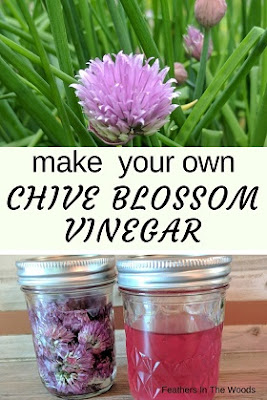I use chive blossoms in a lot of different recipes. They just add such a nice color and flavor to everything they touch! I make chive blossom butter, I use chive blossoms in salads or as a plate garnish, and I also make chive blossom vinegar. Flavored vinegars are easy to make and the pretty pink color of the chive blossoms makes for a lovely colored vinegar.
Flavored vinegars are super easy to make, and once you know how you can come up with lots of different flavor combinations! All you really need to do to make an herb infused vinegar, is pick your herbs and choose a vinegar then put them together and let them marinate a while.
Ok, well...maybe there's a little more to it than that! (but not much!)
How to make chive blossom vinegar
I use either white wine vinegar or rice vinegar for all my flavored vinegars. (it really just depends which one is on sale...I'm cheap like that!) Those 2 are my favorites, but if you're not sure which vinegar you should use, check out Food & Wine's post on the 11 Essential kinds of vinegar.
Once you've chosen a vinegar you're ready to get started.
- Clip your chive blossoms all the way at the top of the stem.
- Rinse in cool water to remove any tiny critters that may be on them.
- Let air dry for an hour or so, or wrap in a lint free towel and shake to dislodge water from between the flower petals.
- Place chive blossoms in a mason jar. You don't have to break them apart, I always throw them in whole.
- Cover chive blossoms with your vinegar of choice.
- Cap jar and let sit in a cool, dark location for about a week, shaking every 2 days.
- Strain and pour the infused vinegar into a clean bottle or jar. Cap tightly.
- Chive blossom vinegar can be stored in a cool dark area for up to 6 months.
A few interesting points:
Some people like to heat the vinegar before using it to speed up the process. I find it unnecessary but if you want to heat your vinegar first, heat it in a small saucepan until it just begins to simmer. Do not let it boil.
Chive blossom vinegar has a light oniony flavor after a week. For a stronger flavor allow the vinegar to infuse for another week before straining and bottling.
While chives and chive blossoms are edible, the chive blossom stems are particularly tough (almost woody) and are better suited for the compost pile than the kitchen.
The great thing about this recipe is that you can make as much chive blossom vinegar or as little as you'd like. As long as you make sure the blossoms are submerged in the vinegar, the proportions will be correct.
Not sure what to do with your chive blossom vinegar? I use it on salads instead of dressing or toss it with cucumbers as a light marinade.
Chow Hound has a great article on What to do with flavored vinegars, and Vinegar Nut has some great ideas on Cooking with infused vinegars. Enjoy!
~L
Want gardening and healthy living information sent right to your email weekly? Click right here to join my list and get new posts sent directly to you the day they're published!




Like the idea of chive vinegar..am going to try. However, my homegrown chive stems are not tough and I use them much like green onion tops. Snip them and use in salads, omelets, quiches, etc. They have a sweeter, milder taste than green onion and I like that.
ReplyDeleteThat's a great idea! Unfortunately mine are almost woody...but it's good to know that softer ones can be eaten!
DeleteLisa